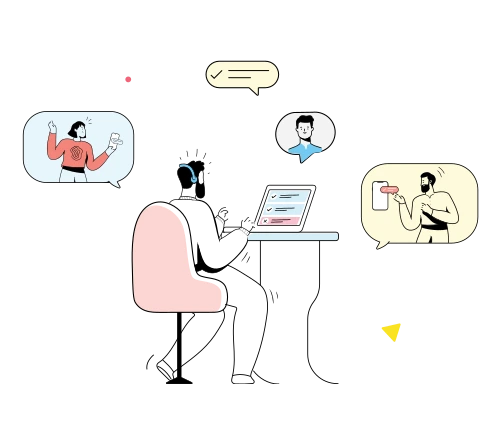Our comprehensive customer service chatbot guide will help you understand how your organization can leverage chatbots and conversational AI to improve user experience. In this guide, we will define what customer service chatbots are, how they work, and how to choose the best chatbot for your organization’s needs.
Artificial intelligence and customer service have become intertwined in the last decade, resulting in the creation of customer service chatbots. These chatbots are powerful tools that can take your customer service strategy to the next level, providing fast, accurate, and remote solutions to customers. In addition to automating customer service, chatbots can also handle lead generation, marketing, and customer feedback, making them versatile and efficient solutions for businesses.
With technological advancements in AI, ML, and NLP, chatbots are more sophisticated than ever before. This has led to an increasing number of companies investing in chatbot solutions, with the chatbot market projected to reach a staggering $1,953.3 million by 2027.
In this comprehensive guide, we will answer the question “What is a customer service chatbot?” and explain how they work. We will also explore their business use cases and benefits and guide you in choosing the right chatbot for your specific needs. By the end of this guide, you will have a solid understanding of customer service chatbots and make an informed decision on implementing them in your business.
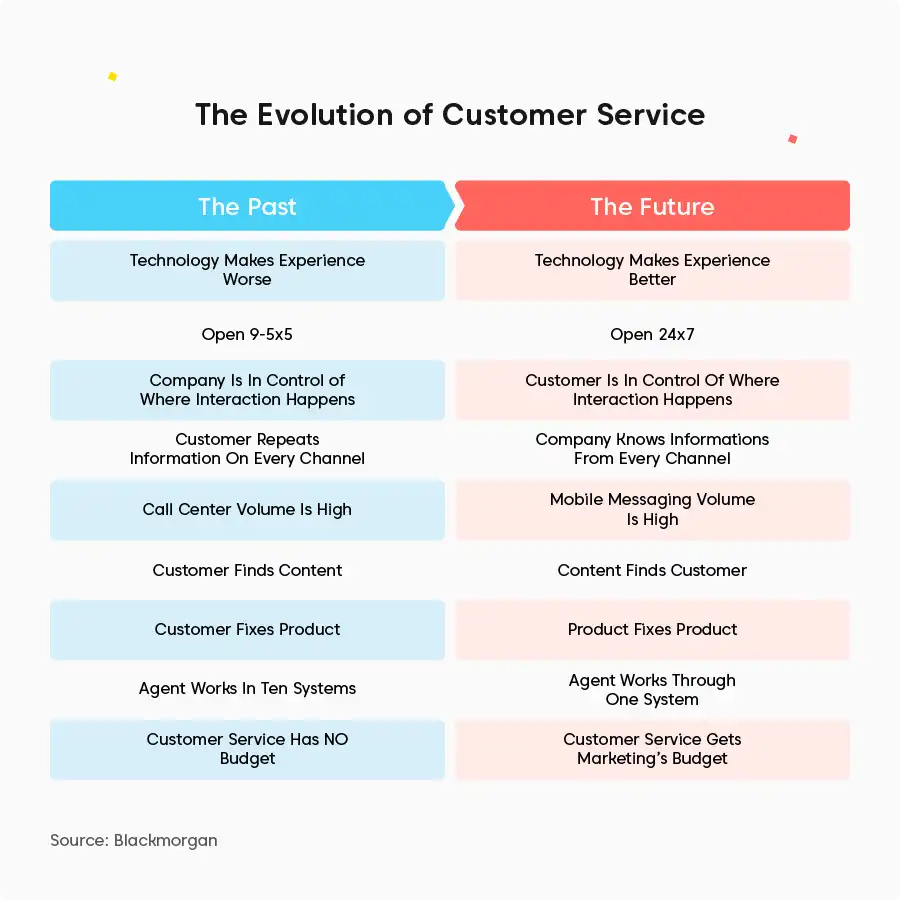
What is customer service?
Customer service is the process of supporting your customers before and after they buy your products or services. The goal of customer service is to stay available for your customers throughout their discovery, use, optimization, and troubleshooting of a product or service to build long-lasting customer relationships. Offering a good customer service experience is how you win customers’ trust and loyalty.
The evolution of customer service
The concept of customer service dates back to the time when humans first started trading. Of course, over decades, the modes of communication have evolved, but even today, the goal of customer service is to meet customers’ expectations and deliver better experiences than the competitors. Let’s see how customer service has evolved over time.
The Telephone
Soon after the invention of the telephone by Alexander Graham Bell in 1876, it became an effective tool for sending and receiving customer complaints and queries. It became a way for brands to directly communicate with individual customers and hear about their pain points.
Call Centers
In the 1960s came the call centers where with just the touch of a button, agents could directly call customers and sell their products and services. It was then that businesses started analyzing and collecting customer data such as the preferred time of calling and customer interests and invested in digital innovations like IP telephone systems, caller ID or caller line identity (CLI) on the screens of telephones and the headsets used by call center executives to answer calls.
1800 Toll-free Number
With an intention to encourage customers to share their feedback, the concept of a toll-free 1800 number was introduced in 1967. The clear motive behind launching a toll-free number was to increase convenience and also that the customers don’t have to pay to share their grievances. However, because numbers were tied to geographical areas, either only 5% of these calls were free or the companies had to keep several toll-free numbers. To solve this problem, in 1981, AT&T scientist Roy Weber came up with an even better innovation. He actually made the 1800 numbers toll-free by connecting them to a computer file, like a hosting server.
Interactive Voice Response
Interactive voice response technology or IVR was developed during the 1970s by Bell Telephone Laboratory as an automated phone system technology that allows incoming callers to access information via a voice response system or by utilizing menu options via touch-tone keypad selection or speech recognition. Later when companies found the computer voice response technology to be expensive, they started using recorded voice responses embedded into IVR dialogue trees to synthesize human conversations.
It was 1971 when Ray Tomlinson invented and developed electronic mail, as we know it today, by creating ARPANET’s networked email system. It was later in the 1990s that email became an integral part of our everyday lives and businesses as well started using it for customer service. However, email communication suffered from language barriers but this problem was soon solved with the development of customer support software.
Live chat and chatbots
In the 1990s, CRM became an integral part of marketing and sales and companies started using software that could be integrated with the CRM to offer personalized support to customers. Software such as live chat and chatbots started gaining popularity and companies used them to provide real-time assistance to their customers. Chatbots also enabled customer self-service and resolved 80% of repetitive customer queries with minimal human intervention.
Social media and messaging platforms
Social media and messenger apps such as Instagram, Facebook, and WhatsApp are emerging as the primary mode of communication between brands and customers. These social media platforms have a combined user base of more than 3 billion and it only makes sense for companies to leverage these platforms to get closer to their customers. This has also given rise to messenger bots that are used to automate customer engagement across these channels in multiple languages and improve customer experience.
Voice Bots
Voice-enabled assistants have been around since the 1960s, but it was only with the launch of Siri in 2010 that they started gaining popularity. Ever since then, voice assistants such as Siri, Alexa, and Google Assistant have become an integral part of our everyday lives. We can also see the adoption of voice-enabled chatbots in customer service. AI-powered voice recognition bots comprehend the speaker’s request through natural language and voice recognition in real-time without human intervention and use it to converse with the caller with a high success rate of up to 98%.
What are customer service chatbots?
A software application that automates query resolution and problem-solving using artificial intelligence and natural language processing (NLP) is known as a customer service chatbot. It can help businesses serve customer queries within no time through platforms such as websites, mobile applications, and even social media.
Businesses have been increasingly adopting chatbots and incorporating them into their customer service strategies to automate repetitive tasks and assist customers throughout their journey. The basic functioning of a customer service chatbot is as follows:
- The user asks a question
- Chatbot applies AI algorithms to the customer’s query
- It then delivers a response to the consumer via text or voice
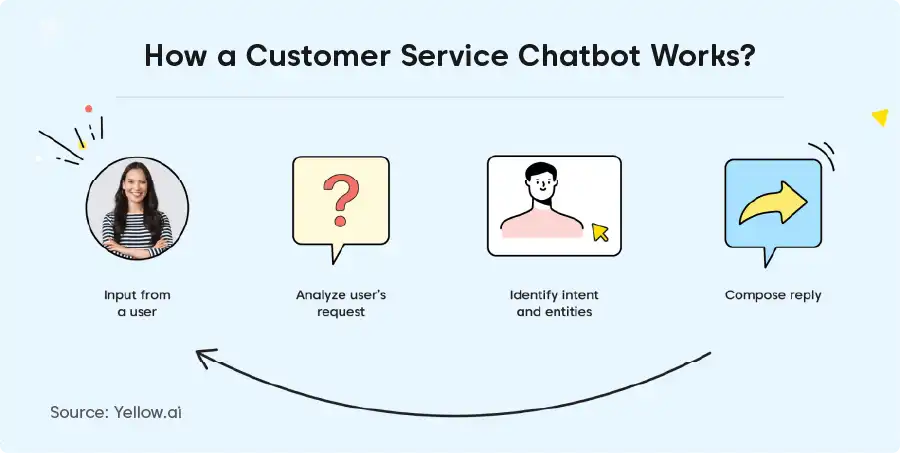
It is during the second step that the chatbot employs NLP, AI and machine learning. These technologies help them interpret users’ queries and recognize verbal cues to better understand the user’s sentiment. The chatbot also uses previous customer data to understand their journey, infer feelings, such as frustration or anger to add more fluidity and personalization to the conversation.
As we discussed above, such chatbots become more intuitive with time. As they interact with customers, they develop more sensitivity and learn more effective ways to respond to queries. This results in more accuracy and enhanced customer experience. AI chatbots can also be integrated with an intranet of other applications to make the customer journey more seamless.
10 important benefits of customer service chatbots
The use of artificial intelligence and automation in customer service can solve many problems like providing support during the off-hours, removing the language barrier, and reducing the workload on customer service representatives. Let us understand the benefits of customer support automation for businesses with chatbots in customer service.
1. Provide an improved customer experience
The overall customer experience is largely dependent on customer service. Good customer service ensures an excellent customer experience and improves customer satisfaction, customer retention, and customer loyalty towards the brand.
With chatbots for customer service, businesses can assist customers and resolve their queries with a speed and accuracy that is humanly impossible. Chatbots can become a one-stop solution for customer service. 72% of customers consider it a bad experience when they need to explain their issues to multiple people.
Quick query resolution and better customer service can improve customer experience to a great extent. All these efforts combined can help businesses with an overall top-notch customer experience.
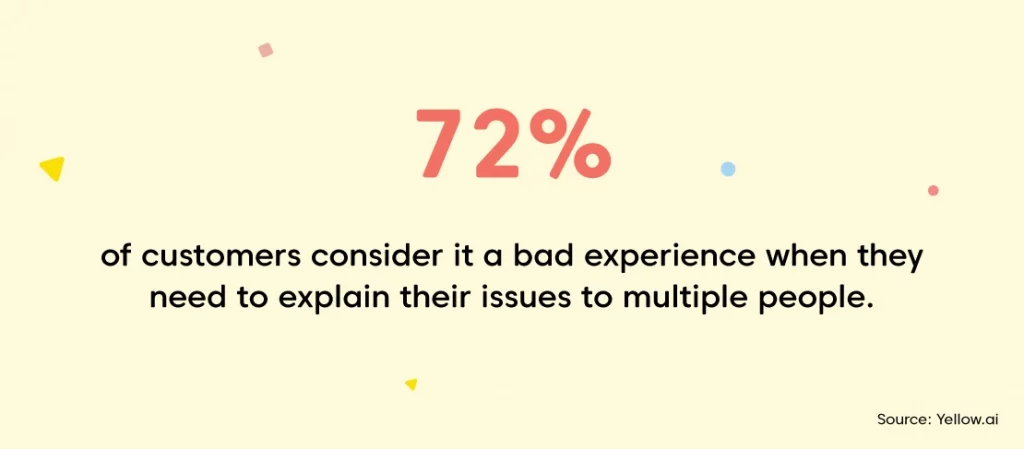
2. Personalize every interaction
For businesses, every customer interaction counts, even the small ones. Customer service chatbots can personalize every interaction and make sure that the customer feels valued.
Chatbots are data-trained and can fetch the customer details like name, order details, and history information easily. With all this data at their disposal, chatbots can quickly resolve all customer queries as per their history with the company.
For example, if a customer wants to track their order, they don’t need to enter their order ID or any other details. They can simply ask the chatbot “where is my order?” and all the details will automatically pop up.
3. Round-the-clock customer support
Chatbots ensure zero wait time for customer support. They are available 24×7 throughout the year for resolving issues faced by customers. No off-hours, public holidays, or timezone differences can stop your customers from being satisfied with the business.
Businesses can provide instant responses to their customers over every channel with the help of artificial intelligence and automation. However, in the case of complex queries, human intervention is necessary for query resolution.
Providing quick responses and resolving problems over the first call can have a huge impact on your customer base and can give you an incomparable competitive advantage.
4. Scalable, measurable, and achievable customer service
Customer service chatbots are an upgradation for the customer service department of a business. With chatbots, the customer service team can close multiple queries at the same time. Unlike human representatives, chatbots can take up hundreds and thousands of conversations at a time and respond to them with their full potential. This scalability is humanly impossible and can be achieved only through automation.
Along with scalability, customer service chatbots come with an insights dashboard for measuring and tracking all the customer support KPIs for the team. Using chatbots for customer service, businesses can now set improvement targets even for the support team and work towards achieving them.
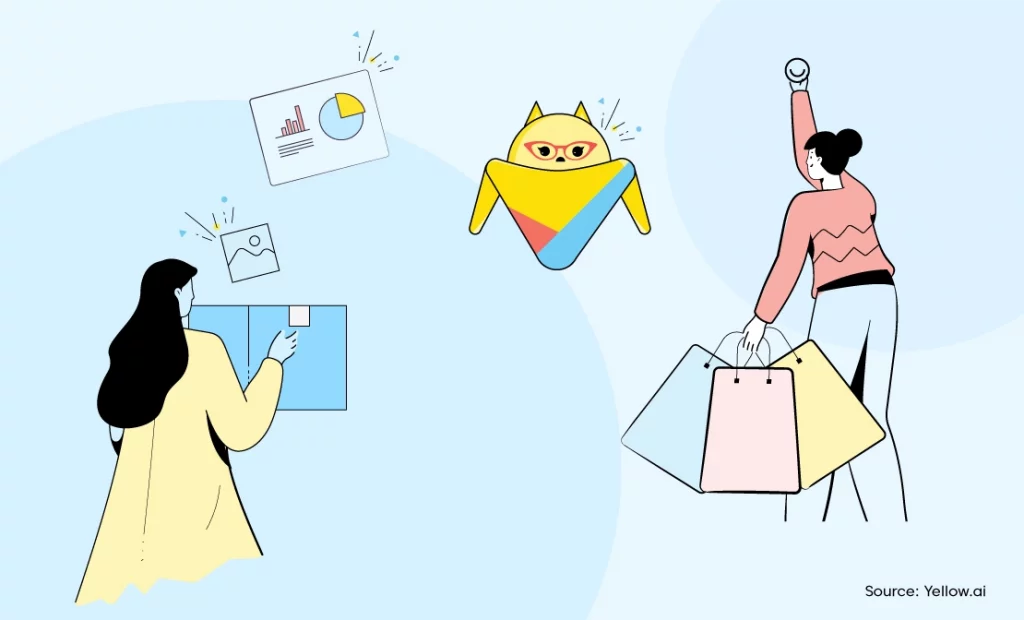
5. Lower operational costs
Human representatives for customer service cannot be replaced with chatbots. Software applications can be an important tool but not a replacement for human resources. Chatbots can assist the customer support team with quick query resolution but cannot fill in case of complex queries that need human intervention.
However, they can save a lot of time and operational costs for businesses by reducing the volume of work and handling all the monotonous tasks of a customer service representative.
This can lead to a better work environment and happier employees for the customer support team. Businesses can save a lot on operational costs by saving all the efforts of hiring and training employees.
6. Provide seamless agent handoffs
For delivering better customer support, seamless agent handoffs are necessary. Customers can feel annoyed waiting for the customer service representative to take over the conversation. Therefore, the process needs to be seamless.
Chatbots ensure a smooth handoff in case of complex queries. They provide all the previous information about the customer and take a back seat.
The right balance between communication between the representatives and the chatbot also makes it easier for the representative to take a break from regularly supporting customers.
Businesses can automate all the repetitive queries that need basic information and leave them for the customer service chatbots. Whereas complex queries can be taken by the agents.
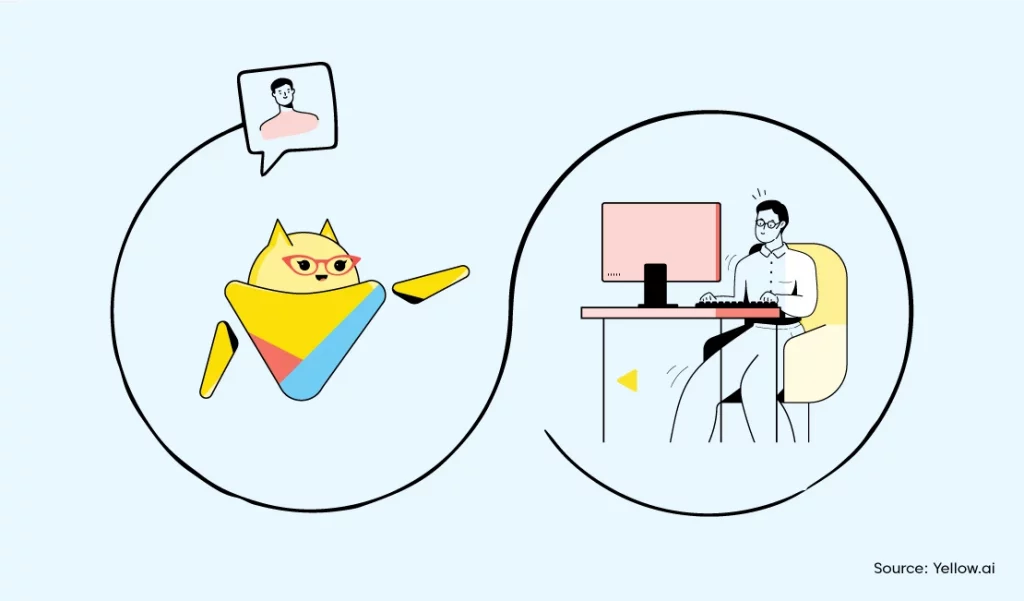
7. Obtain feedback in real-time
Consumers are more comfortable with chatbots and trust them with information. They readily provide feedback and share their issues during a chat. This makes chatbots the best source to obtain customer feedback, reviews, and ratings.
Businesses can ask for feedback after every interaction, every purchase, or every query resolution, as per their KPIs and business needs.
Chatbots do well with feedback as they make it interactive and easy to answer by consumers. Obviously, filling out a feedback form has much more friction than answering a question during an ongoing conversation with a chatbot.
8. Social media support automation
All of us know that social media has become a marketplace, but the question is if it is a customer support place too. If businesses can market their products and services according to customers’ presence, support must also be provided on the channels where customers are present.
Social media and conversational AI have created a wave in customer experience strategies for businesses. Organizations are shifting to providing omnichannel customer service. Automating WhatsApp messages and Instagram DMs and using social media for customer service is providing businesses with an opportunity to know their customers better and support them better.
9. Reduce IVR churn
IVR (instant voice response) systems can be time-consuming and annoying for customers. Listening to the menu and holding calls for customer care representatives can become friction for customers to re-visit your business.
Customer service chatbots can simplify the process and help customers with instant responses that efficiently solve their queries. The process of problem-solving can become very easy with chatbots and also the IVR system churning can be reduced.
While IVR can make mistakes in routing customer queries to teams, automating the process with conversational AI chatbots for customer service can reduce the chances of such mistakes.
10. Satisfy customers and track sentiments
When all queries are solved and all requirements are met, customers are satisfied with businesses. With the use of conversational AI, businesses are able to see a shift in customer behavior. They’ve seen a rise in customer satisfaction, and customer retention rates.
Chatbots in customer service play a vital role as they can track the sentiments of customers and understand how they feel about the business.
However, businesses must track customer service KPIs like NPS (net promoter score), CSAT (customer satisfaction rate), or CES (customer effort score) and continually monitor the performance of their chatbot.
AI chatbots are on their way upward and are not stopping with these benefits. Conversational AI and automation are intervening and excelling in every business process, be it marketing, lead generation, sales, customer service, HR, or finance departments. Broadly used for customer service, these chatbots have multiple use cases in each business department.
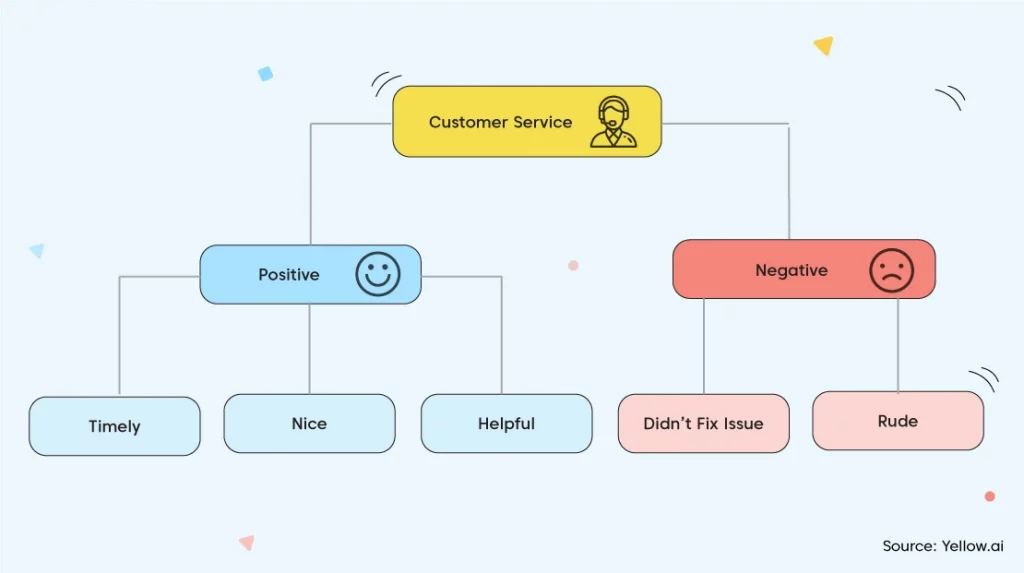
Practical use cases of customer service chatbots
The customer service department can also be classified into many different business segments based on their functionality. Chatbots for customer service can be used in all of these segments.
1. Use chatbots to provide help to customers
Be it FAQs, tracking of orders, payment processing, or complaints regarding the products or services, the chatbot in customer service can take them all. Using NLP, these chatbots can understand what customers are looking for and provide the exact information as required. Customer queries will not just be answered, but answered instantly, no matter the time of the day, or day of the week. Customers will be satisfied with the best possible service.
2. Use chatbots for collecting customer information
Customers trust chatbots and share their details on the chat interface. This information can prove to be extremely useful for businesses. If the information is about a potential customer, it can be a lead, and if the information is feedback, it can be used in looking into the shortcomings and working on them.
3. Use chatbots for renewals and payments
Businesses with subscription-based models can send their customers notifications about their renewal and payments. Even for one-time payments, chatbots can support customers for simple transactions. Even for any mishaps, customer service chatbots can help customers with information about refunds or returns. Businesses can develop trust in the hearts of customers by using chatbots for customer service.
With such benefits and use cases of chatbots in customer service, who would like to miss a chance to deploy them to their business website, mobile application, and social media.
How to choose the best customer service chatbot for your business?
At this point, you might be wondering how to use all the information you’ve learned in this guide to choose the right customer chatbot solution for your business. Rest assured; we have put together a quick checklist of things you should consider to guarantee satisfaction with your choice.
1. Who is your target user?
The first step in choosing your chatbot is knowing who the end user will be. Create a customer persona to outline your typical customer’s needs, demographics, and behavioral information. Understanding the needs you need to fulfill will help you narrow down the features and functionalities your chatbot should have.
2. What are your goals for your customer service chatbot?
Once you have a clear picture of who your customer service chatbot will be for, you must identify the tasks you want your chatbot to handle. How can your chatbot provide value for your clients and enhance their experience? Thinking this through will help you determine the features your chatbot needs to reach your goals.
3. What digital channels do your customers use?
Customer service chatbots can be implemented in numerous digital channels, including websites, mobile apps, social media, messaging platforms, and voice channels. It’s crucial to understand where your target user goes to look for information and where your chatbot would best serve your business objectives.
4. What features and capabilities are necessary to achieve your goals?
After compiling all the data from the earlier steps, you should have a decent notion of the features your customer service chatbot needs to have. For instance, a simple menu-based chatbot could accommodate your expectations if you want your chatbot to gather details about a customer request before transferring them to a live person. In contrast, you’ll need an AI chatbot if you want it to gather user data to develop personalized customer experiences.
5. Do you want to create a customer service chatbot from scratch or use a ready-made solution?
Though it can seem complicated, creating a chatbot is now simpler than ever. A team of skilled engineers had to be hired in the past, and creating a custom chatbot cost a considerable budget. Today, you can create your own chatbot tailored to your company’s requirements in a matter of minutes with the aid of a no-code chatbot builder.
Conclusion
We’ve covered a lot in this guide, so let’s recap some key takeaways. We learned that a chatbot is a computer program that simulates human conversation using natural language processing and machine learning to interpret and react to user inputs. Customer service chatbots have many applications, from automating customer support to streamlining HR processes. They can save businesses time and resources while offering users a more convenient and tailored experience. As technology advances, customer service chatbots are growing increasingly more intelligent and are already capable of assisting humans over voice and other modern channels.
If your business is looking for an upgrade in the customer service team and is ready to engage conversational AI for customer interaction, you have reached your destination.
Yellow.ai is the world’s leading platform for total CX automation. We can help your business with all your needs by providing exceptional customer service and improving the overall customer experience.Have all the requirements in place? Try your hands-on no-code bot building with our bot studio. You can create your own customer service chatbot within 10 clicks and give your customers a heart-winning experience










